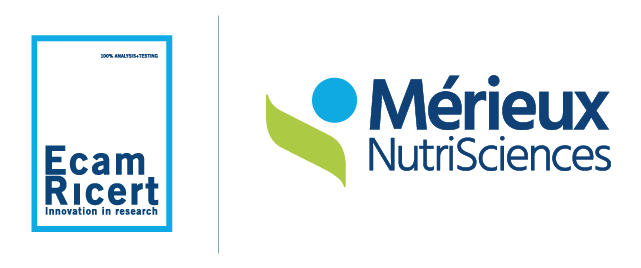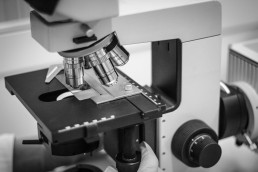
R&D
ECAMRICERT, thanks its technicians’ competence, has developed across-the-board experiences and abilities in strategic research and innovation during time. In this context it usually conducts R&D activities, involving all the different sectors in projects co-subsidized on a regional (POR Veneto and FSE funds), national and European (Horizon 2020) level. ECAMRICERT accompanies through this growth its clients as well, planning research activities, selecting the best European and national university centers, setting up funded educational paths, all of which is oriented to a constant improvement of both products and processes.
Licenses
European
- European license “Diffractive optic element”
- European license “Procedure for the production of flour-based bread in a box and a fermented composite of milk and pure bacteria culture origin”
National
- Italian license “Method to identify in time bacteria and milk fungi colonies”
- Italian license “Process for the production of cement conglomerates made of industrial wastes of marble loam with the addiction of wastes of exhausted ground coffee”
Projects
European
The B-Impact (Bronze-Improved non-hazardous Patina CoaTings) project aimed to develop innovative protective eco-compatible and non-dangerous upholstery, to protect bronze surfaces exposed to the external environment. In fact, bronze artifacts and monuments exposed to open-air are subject to degradation processes, especially in polluted environments. The process of corrosion and the degradation of the surface’s stability and look take place on new exposition bronze surfaces as well as ‘old’ bronze surfaces. Their protection and maintenance is a great challenge, which requires a constant economic effort. In the range of Cultural Goods conservation, ‘ready-to-go’ customized formulations were found, based on advanced protection strategies to reduce the maintenance costs, as well as effective conservation solutions for the final customers, including local authorities and other sectors (architects, artists, museums, etc.)
Begun March 2015, finished March 2017

The innovative and economic potential of MNM (Manufactured Nano Materials) is threatened by a limited comprehension of the related EHS (Environment, Health, and Safe). While the data of toxicity are always available, the importance the legislator’s eyes is often unclear or undemonstrated. The restriction of commercialization times of new MNMs entails the necessity of an urgent action by regulation authorities. NANoREG is the first project of the 7th PQ to give necessary answers to regulators and legislators about EHS, connecting them to a scientific data and testing methods evaluation. On the base of questions and requisites given by legislators and stakeholders, NANoREG retailed: answers and solutions from existing data, integrated with new knowledges; a series of procedures with instruments for MNM’s risk evaluation, characterization, toxicity tests and exposition measurements; new testing strategies fitting the requirements of innovation; a close collaboration between authorities, industry and science which led to new efficient and practically applicable approaches of risk management for MNMs and products containing MNMs. The interdisciplinary approach, involving the three main interested subjects (regulation, industry and science) significantly contributed to decrease the risks coming from MNMs in industrial and consumption products.
Begun March 2013, finished December 2016

Begun February 2015, finished January 2017
Despite the increasing number of macro-molecules with a potential impact on the treatment of lethal systemic diseases, those therapies could not satisfy the expectations, because they cannot be given in the most efficient way cost-wise and with the maximum reception of the patient: oral. Availability of a form of oral administration contributes to a notable improvement of classical therapies and an increase in the number of new viable therapies. To achieve this, the final objective of Trans-Int was to project some nano-carrier specifically adapted to face the gastrointestinal ecosystem and utilize them to develop new oral nano-medicines for socio-economic high-impact diseases (such as metabolic diseases, painkillers). The main concept of Trans-Int is rational project of oral nano-medicines, based on safety, mechanics, bioengineering (multi-functional nano-carriers: high useful load, protection from drugs, efficient transportation of drugs, controlled release) and pharmaceutical technologies standards (deductible technology and stability). The project began with platforms of nano-carriers on which partners were free to operate: nano-capsules, nano-particles, micelles made of combinations of lipids, polypeptides and polysaccharides, until optimizing and redefining selected nano carriers. The project allowed creating: a prototype of oral nano carrier with a complete package of GLP-tox, which might be applied to deliver a relevant number of peptides molecules; a nanomedicine satisfying the profile criteria of the product’s target, with a complete pre-clinic evaluation package; a significant integrative knowledge on possibility and potential of oral nano-pipes and nano-pharmaceutical products
Began May 2012, finished April 2017

One of the biggest challenges for legislators in the ever-evolving landscape of new nano-materials is how to project and implement a normative process strong enough to manage a system of manufactural nano-materials (MNM) that rapidly diversifies with time. Nevertheless, it is not only a matter of complexity, since nano-materials are a problem to legislators also because of their validity of data decreasing with time, as said by the notorious principle of half-life of facts (Samuel Arbesman, 2012). This means that what is an accepted truth now, will not be valid between 20 or 30 years. The challenge is setting up a normative system flexible enough to be able to face new goals and requirements in the future, and in this development and introduction of Safe by Design (SbD) principles will help. Credibility of such a normative system, supported by the implementation of SbDs, is essential to industry, which even though accepts the necessity of an adequate regulation, requires it to be persecuted in an economically convenient and rapid. The NanoReg2 project, built around the challenge of pairing SbDs to the normative process, will prove and establish SbD as main cornerstone in validation of a new manufactural nano-material. It is widely recognized by industries and regulation agencies, which are immediately necessary grouping strategies for nano-materials. The ECETOC formed a task force on nano-materials grouping and a group is working on the categorization NM inside OCSE’s WPMN. However, until now it was impossible to set reliable group concepts and accepted rules. Grouping concepts developed by NanoReg2 can be considered a great innovation; therefore, orientation documents on NM grouping will not only support new industries or regulation agencies, but would also support the commercial launch of a new NM
Began September 2015, finished August 2018


The Gov4Nano project will develop the first implementation of a future-proof operational Nano Risk Governance Model (NRGM) that addresses the needs of the transdisciplinary field and innovative (and key enabling) character of nanotechnology.
Gov4Nano will take into account the particulars of different generations of nano-technologies and risk/benefits/public concerns to develop an integrated approach connecting the scientific, regulatory and market layers and the different actors involved from generation of data and knowledge to application in legislation and standards, and propose the basis for efficient and effective risk governance of nanotechnologies.
The Gov4Nano project will design and establish a Nanotechnology Risk Governance Council (NRGC), to create a trustworthy and objective international umbrella for the risk governance of nanotechnologies.
Began January 2019, finished December 2021
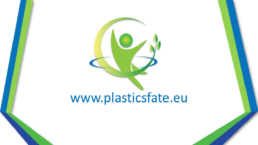
PlasticsFatE is a 48-month project funded by the Horizon 2020 Research and Innovation programme of the European Union. The project have been run from 1st April 2021 to 31st March 2025.
The main goal of PlasticsFatE (Plastics Fate and Effects in the human body) is to improve our present understanding of the impact of micro and nano plastics (MP/NP) and associated additives/adsorbed contaminants (A/C) in the human body.
The project consortium is made by 28 partners from 12 countries (11 European + 1 Indian).
The specific objectives are:
- Develop a panel of well characterized MNP test and reference materials
- Establish validated methods for measuring MNP in complex matrices
- Assessing exposure levels/sources (food, drinking water, air, human tissue, blood, faeces, urine, mucus, personal care products) and fate of MNP in the human body
- Develop in vitro/in vivo models and study effects of MNP in the human body
- Generate integrated human risk assessment and management strategy for MNP
- Demonstrate feasibility of established methodologies by case studies
- Contribution to relevant EU strategies and international standardization
For more details the website of the project is: www.plasticsfate.eu
National
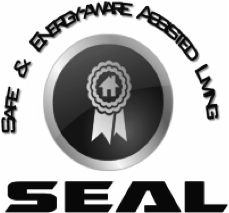
The SEAL (Smart & safe Energy-aware Assisted Living) project has the goal of developing new knowledges, products and services to introduce systems for domotic environments (AAL, Ambient Assisted Living) in the market, which could services orientated to safety (for people and environments) and sustainability (in terms of energetic efficiency). In this, SEAL falls into the topic related to Smart Cities development, which provides for the integration of unities (on a building, structure, community level) operating smart themselves.
The project unfolds in 7 Objectives of Realization (OR):
OR1- Materials and processes: innovative materials and transformation technologies
OR2- Devices: innovative mechatronic devices
OR3- Activation: highly efficient and reliable electric activators
OR4- Device network: domotic systems to improve energetic management, environmental comfort and air quality, accesses safety and control
OR5- CCTV network: networks of cameras for video-monitoring and users assistance
OR6- Data and systems: infrastructure of domotic residential systems or AAL, fusion of data provided by mixed sensors
OR7- Experimenting: experimenting prototypes in PAs, with system performance test
The innovative services were situated in user’s safety sectors and in energetically efficient buildings management (two of the settings considered more interesting to potential users of domotic systems)
SEAL project’s ultimate goal was developing methodologies for intelligent systems, based on mutual interaction between devices (CCTV and sensors networks and auctioning devices, though as logical elements not necessarily physically distinct), in order to allow mixed multi-agent network build-up safety-aimed (for people and environments) and sustainability (in terms of energetic efficiency and aware utilization of resources). To accomplish that objective, innovative devices were created and also a general system infrastructure to elaborate the info shared on the web. This is based on a non-owned, open register, able to manage the flow of data, to which the systems (devices, sensors and activators) interface as plug-ins, extracting or submitting information clearly to the user of said services. In order to accomplish the ultimate goal, advanced solutions and applications were developed in the following research fields: innovative production materials and processes, highly performing and efficient electric activations for mechatronic systems, sensors and actuators integrated networks miscellaneously distributed, CCTV networks, socio-sanitary and juridical aspects for AAL systems.
Began March 2013, finished December 2016
Regional
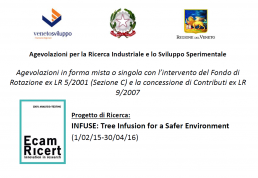
Woody plants’ endotherapy consists in introducing phytohealth products distinguished by systemic features directly in the trunk through injection and taking advantage of the relocation of those substances through lymphatic system with the aim of treat every part of the tree.
In urban areas, the endotherapy represents the best solutions, being that it does not expose the operator nor the inhabitants to the dispersion of phytomedicines, typical of other treatments such as sprayings, paintings and injection to the soil. Everything is done with the maximum efficiency from a utilized product quantity point of view and an almost eliminated drift in the surrounding environment. The firm is extremely sensitive to that topic, so much that the EU will most likely dictate to make public green treatments exclusive for endotherapy from 2014.
Injection to the trunk or roots by means of invasive pressure systems is not a new operation, considering that the first jobs with forced introduction are bonded with studies about tree feeding from the ‘30s (Collison et al., 1932). Nevertheless, this method causes the damaging of the tree, because of the notable number of holes made with electric drills (tissue removal damage, shift warming, embolization and creation of continuity for possible pathogens).
With the goal of avoiding such alterations was born BITE (Blade for Infusion in TrEes), an invention by the University of Padua. Its innovative lenticular blade inserts between fibers without removing woody tissues and allowing a quick cicatrization. With such method it is not necessary to implement artificial pressure and instead choose an injection related to the Venturi effect, created by the blade and to the natural absorption to an atmospheric pressure, which speed depends on the plant’s features, phenological phase and other physiologic parameters (eg. leaves mass and health state) and conditions. There are six active principles currently authorized to endotherapy in Italy, covering not enough of the guest-parasitic couple spectrum: thiabendazol (a fungicide only authorized against plane tree’s anthracnosis), azadiractine, clorpirifos-metil, imidacropil and abamectine (insecticides and acaruscides) and glifosate (a herbicide). Due to the extremely lacking availability of efficient formulates, with this project we faced a multi-year research plan, focused on the optimization of new endotherpicists on a superior level of specificity. The main point of the project was verifying the phyto-medicines’ active principles (phyto-regulators, dissecants, fungicides and insecticides) already authorized in Europe and potentially the study about molecules not tested yet, together with the experimenting of transmissives and formulations that make them alike to lymph (eg. pH, salinity…) and allow the functioning of the treatment. Such solutions have been tested on the field for the single vegetal species and the associated pathogen. All inside of a global perspective of overview of the tree-pathogen-environment system thanks to the analysis of the environmental characteristics (such as radiation, windiness, air temperature and humidity, stomatic resistance, degree of soil saturation…) at the time of treatment, with the goal of obtaining the most effective and versatile combinations. Therefore, the application fields were more different, from public green to orchards, to research of the most eco-compatible solutions. The analysis of phyto-medicines’ remains in leaves and fruits, with treatment marking times, were the key to select the most effective combination from a point of view of the disease’s annihilation, but with shorter marking times.
Began February 2015, finished April 2016
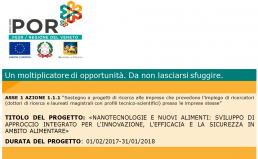
Nanotechnologies and new food
Development of integrated approach for innovation, efficiency and safety in food range.
The project overviews the context of smart agrifood specialization as developed in Veneto’s regional strategy s3. Starting from the analysis of weakness points of the sector in region, such as the preponderating of small productive entities, and the consequent difficulty to understand innovation opportunities, the project aims to develop useful instruments for PMIs to increase in a simple, rapid and sustainable way the innovation of food products. Especially, activities are focused on the ‘food nutrition, health and safety’ development trajectory. Between these three topics, safety represents an aspect considered the most important by firms in general, as indicated by Veneto’s RIS3 report (page 95). Aiming to evaluate the safety of new ingredients and formulations, the project will develop an integrated and automatized prototype of an in vitro human digestive model, projected and validated according to European standards and suiting law regulations. From the innovation point of view, nanotechnologies will be applied as enabling technologies. From the PMIs point of view, nanotechnologies allow to innovate transformation processes, and therefore valorizing vegetal production, niche ones as well, through a defined differentiation, compared to products already present on the market. Innovative ingredients find their application, for example, in food integrators, functional food, and to a special medical purpose, categories of products with a great benefit. For what concerns innovation drivers and referring to European politics of active aging, malnutrition represents one of the main causes of elders’ fragility and decrease in their cognitive capacities. The use of functional food and integrators is an integral part of the NUTRILIVE project (Illario et al., 2016) for active aging. The development and verifying the efficiency and safety of specific products, with a high bio-availability and calibrated for nutritional and health conditions, may be a deciding factor in improving the nutritional status, completing a healthy, balanced diet and at the same time helping to prevent functional and cognitive decay.
Researchers action 1.1.1 – Enhancement of by-products and agricultural and forest wastes: nutraceutics and nanotechnologies
Enhancement of by-products and agricultural and forest wastes: nutraceutics and nanotechnologies
Active ingredients of natural origin, plants in particular, are increasingly used as valid alternatives to the use of drugs, especially for chronic diseases that require medication for prolonged periods. The sources of active ingredients are often ad-hoc plants, selected for their content of extractable active ingredients. For example, aromatic plants for essential oil with antibacterial effects. However, the same active ingredients can be present in significant concentrations in other plant species, cultivated for other uses and used in economic supply chains that are also far from food, such as the forest sector. For example it is well known that the bark of tree species contains anti-oxidant and anti-inflammatory substances (white fir, willow). Referring to the recent calls of the European Commission regarding the development of a circular economy, and a more sustainable agriculture, it becomes important to develop methods to enhance processing waste and by-products of agricultural and forestry activity. This approach also involves the identification of innovative active ingredients, not yet fully exploited on the market, in order to give greater added value to possible commercial products. Finally, it’s increasingly important to develop effective products accompanied by technical and scientific information to support nutritional and health claims. This proposal aims to support the agricultural and forestry companies of the Veneto region, also with biological productions, for (i) the exploitation of processing waste and by-products as a source of active ingredients of nutraceutical value, (ii) support to the study of economic feasibility taking into account the level of usable active ingredients, (iii) development and testing of effective and safe nanotechnology formulations for the production of competitive commercial products. Since the absorption and activity of an active ingredient are the basis of an effective formulation, the use of nanotechnologies to create “new foods” with high technological content, well represents the added value needed by local SMEs. Food innovation on a nanotechnological basis must also take into account the different regulations, particularly that on new foods, and the development of a turnkey service aimed at nanotechnological innovation can give a greater boost to innovation and enhancement agriculture and Veneto forestry.
Started on 16/10/2017 it will end on 15/10/2018
Sharing of Methodologies for the Export of Smart Food – CoMeExpo
Intervention made using the POR funding – Objective “Increasing internationalization of production systems” ERDF part European Regional Development Fund 2014-2020
|
AXIS 3
|
ACTION 3.4.1 |
| COMPETITIVENESS OF PRODUCTION SYSTEMS | Export promotion projects for companies and their aggregated forms identified on a territorial or sectoral basis |
SHORT DESCRIPTION
The companies proposing the project “Sharing Methodologies for the Export of Smart Food – CoMeExpo” all belonging to the RIBES-Nest Regional Innovative Network, promoter and manager of the activities, during the many meetings of the Network have identified among the common problems that of need a modular and planned approach to its internationalization strategies that is not always dealt with in an organic way. In fact, often the identification of actions related to the choice of the countries where they intend to export are dictated by the needs of the moment and / or the need to be present in some markets where countries have identified opportunities for marketing and exports of their products.
From these considerations comes the idea of creating a series of activities aimed at sharing experiences, both positive and negative, but all extremely different of the Network Partners proposing the “CoMeExpo” project and together identifying tools and methodologies suitable for the individual companies in order to make them more targeted, suitable and able to optimize the results deriving from the internationalization actions that are intended to be carried out.
OBJECT
The main purpose of the project is not only to improve the export performance of the individual participating companies, but above all to improve the export model in each single proposing company through the sharing of experiences with the other participants and, not least, to transfer (compatibly with company privacy) methodologies and experiences within the RIBES-Nest network and its other members, also thanks to the use of qualified professionals both from external suppliers and from TEM. Among the expected results there is also the development of a common strategy for participating in the same type of fair through a common path to improve their communication tools and interior layout of the stands.
EXPECTED OVERALL EXPENDITURE: € 299.500
EXPECTED TOTAL CONTRIBUTION: € 149.750
LIST OF COMPANIES THAT PARTICIPATE IN THE PROJECT:
+ WATT SRL
ECAMRICERT SRL
FAVERO ANTONIO SRL
LATTERIA DI SOLIGO SCA
Started on 07/10/2017 it will end on 16/07/2018
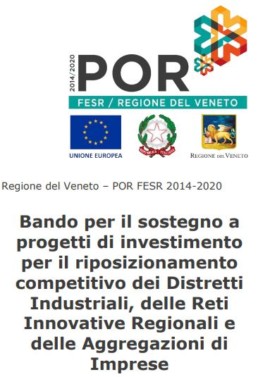
Digital Laboratory and Augmented Reality
ACTION 3.3.1 – SUPPORT FOR COMPETITIVE REPOSITIONING, MARKET ADAPTATION CAPACITY, ATTRACTIVENESS FOR POTENTIAL INVESTORS, VITAL ENTREPRENEURIAL SYSTEMS TERRITORIALLY DELIMITED
The project’s main goal is that of innovation and digitalization of the production process, providing for the complete overhaul of the company management system, in order to make it more efficient and innovative. The project is part of the modernization process foreseen in Industry 4.0, as it will allow a complete digitalization of the company, from the acceptance of the samples through a new electronic labeling cloud system with IoT technology to its processing as all the tools will be interconnected and managed with a new LIMS system (Laboratory Information Management System) complete with modules and consulting activities and based on ProLabQ® software. All this will be interfaced with an augmented reality system based on the Maestro® system, ie a structure with integrated modules architecture for the interconnection of skills and business activities through mobile devices (tablets and smartphones) and smartglass.
Started on 08/02/2018 it will end on 21/08/2018

3S_4H – Safe, Smart, Sustainable Food for Health
The 3S4H project “Safe, Smart, Sustainable food 4Health” addresses the issues of food production from the point of view of safety, productivity, traceability, quality and sustainability, and the promotion of good health through proper and careful nutrition. To guarantee the food quality and sustainability of the agri-food supply chains it is necessary to control the production and origin of raw materials and the subsequent transformation of a product, to ensure its nutritional validity, protecting intermediate and final safety. These aspects are accompanied by the concept of sustainability: food production systems must become extremely efficient, supply chains capable of producing safe and nutritious food, while at the same time reducing the environmental impact. During the project, which will last three years, existing food chains will be studied and improved, thanks to the collaboration of the participating companies. Innovative solutions will be tested on systems such as cereal, dairies, vegetables and medicinal plants. The project, which includes 14 companies and five research organizations, is divided into four research lines (WP), a line for management (WP0) and one for the communication of the most significant results to the public and experts in the sector (WP5 ). In the field of food safety (WP1 Safe Food) rapid methods will be developed for the determination of certain pathogens, mycotoxins and contaminants on different food matrices. In WP2 will be addressed the theme of Smart Food and the possibility of enhancing and improving the nutritional capacity of foods also through the addition of components such as biomolecules and innovative phytocomplexes. The WP3 (Sustainable Food) will be dedicated to the sustainability of processes, the valorisation and recovery of by-products, the application of alternative methods in the treatment of raw materials, preferably at low cost. The WP4 (Health) will cover the effects of smart nutrition on maintaining health and a good quality of life.
SUBJECT
- to qualify the raw materials and the products of the traditional agri-food chains (cereal, dairy, vegetable, medicinal plants) in terms of safety and traceability;
- enhance the traditional agri-food typicalities produced by the territory;
- identify new nutritional components (biomolecules, trace elements, phytoderivatives) and develop unconventional methodologies to improve the value of food and food supplements;
- improve production in the food sector through more sustainable methods, exploitation of by-products, reduced energy consumption for safe supply chains of excellence and integrated into the territorial system;
- study the effects of a smart diet compared to a traditional one on some physiological processes;
- improve the competitiveness of partner companies through professional qualification and innovation;
- increase the production and commercial value of the activities related to the sectors of interest;
- develop proactive and continuous partnerships between companies and knowledge subjects or experts in the sector.
EXPECTED RESULTS
Development of suitable methodologies for the rapid and widespread detection of mycotoxins and traceability on raw materials and products of interest to partner companies; study of methodologies suitable for the identification and enhancement of new nutrients in raw materials and products of interest to partner companies; study of suitable methods for the characterization and enhancement of by-products deriving from production and transformation processes from raw materials of interest to partner companies; study of non-traditional and sustainable methodologies for the treatment of raw materials and products of interest to partner companies; study of sustainable methodologies and processes to improve food production, development of a prototype to study the nutraceutical potentials of food in experimental models on the improvement of some physiological processes (sleep / wake cycle, muscle tone); improve the competitiveness of companies through professional qualification and innovation; consolidate and continue the partnership between companies and knowledge subjects, provide useful information on the composition and quality of the products studied in order to promote them not only in Italy but also internationally.
PARTNER
A.I.A. AGRICOLA ITALIANA ALIMENTARE S.P.A.
AGRIPHARMA SOCIETA’ COOPERATIVA AGRICOLA
CEREAL DOCKS S.P.A.
CHELAB S.R.L.
CONSIGLIO NAZIONALE DELLE RICERCHE (CNR)
ECAMRICERT S.R.L.
FAVERO ANTONIO S.R.L.
ILSA S.P.A.
INDUSTRIA CASEARIA SILVIO BELLADELLI S.R.L.
LATTERIA DI SOLIGO SOCIETA’ AGRICOLA COOPERATIVA
MICROMED S.P.A.
MOLINO QUAGLIA S.P.A.
PHOENIX RICERCA E TECNOLOGIE OTTICHE S.R.L.
SALIX S.R.L.
UNIVERSITA’ CA’ FOSCARI VENEZIA
UNIVERSITA’ DEGLI STUDI DI PADOVA
UNIVERSITA’ DEGLI STUDI DI VERONA
+WATT S.R.L.
EXPECTED OVERALL EXPENDITURE: € 5.188.650,00
EXPECTED TOTAL CONTRIBUTION: € 2.797.600,00
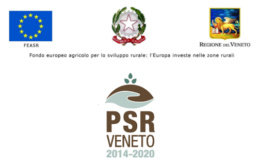
Measure: 16.1.1 of the RDP Veneto Region – DGR 2175 of 23/12/2016
STUDY FOR THE INTRODUCTION ON THE MARKET OF AN INNOVATIVE DRINK FOR THE VALORISATION OF TYPICAL VENETIAN APPLE AND ITS TERRITORY
EXPECTED RESULTS
- Valorisation of the typical Veronese apples and its production territory
- Improvement of farmers’ profitability that will take place following the marketing of the new product (short supply chain)
- Positive benefits for other actors in the local area, primarily winemakers and consumers, as the beverage will be produced in a sustainable manner from an environmental, social and economic point of view
PARTNER
Consorzio Ortofrutticolo di Belfiore Società Cooperativa Agricola (Capofila), Università Cattolica del Sacro Cuore di Piacenza, Ecamricert.
AMOUNT FINANCED
298.936,48 €
WEBSITE
http://www.progettowapple.it/intro-di-progetto/
Started in January 2018 will end in December 2019
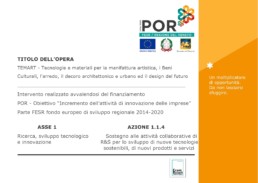
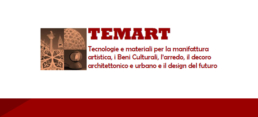
DESCRIPTION
The idea behind TEMART is to enhance and combine artistic and formal knowledge with technical-scientific skills, aiming at the development of new combinations between aesthetic research with manufacturing technologies and materials that meet the needs of innovation in the domains of artistic craftsmanship, restoration of cultural heritage, furnishings (with particular reference to the lighting sector), architectural and urban decoration and design.
Based on this idea, the project will study, fine-tune and validate innovative applications of technologies capable of prototyping and producing components and products of artistic and design value in which the qualities of form and material are combined with the multifunctionality that , in most cases, it is attributable to the nature and quality of the surfaces.
PURPOSE
The final objective of the project is to develop a Decision Support System (DSS-Decision Support System) capable of assisting companies and research centers in the Veneto region in setting up and integrating technologies and processes studied and tested. The collaborative system will in fact incorporate the know-how generated thanks to the intense and extensive experimentation and evaluation activity that will be carried out in the various WPs of the project and will allow the formalization of the highly innovative and knowledge-intensive technical and operational skills from the network. It will assist the decision-making process through the identification of available technological alternatives, the modeling of industrial processes (for example in terms of investment, operating costs and necessary skills) and their analysis in order to guide companies in the industrialization and production of new products, guaranteeing technical and economic feasibility, efficiency and competitiveness.
EXPECTED RESULTS
The project aims to enhance and combine artistic and formal knowledge with technical-scientific skills, aiming at the development of new combinations between aesthetic and formal research with manufacturing technologies and materials that respond to the needs and capacity for innovation in the domains of artistic manufacturing, the restoration of cultural heritage, furnishings (with particular reference to the lighting sector), architectural and urban decoration and design. This intention translates into an extensive and intense study and experimentation activity in the laboratories of research organizations and companies that will lead to the creation of a collaborative Decision Support System (DSS) capable of assisting in the development and integration in the value chain of innovative technologies and processes that will be the subject of the industrial research and experimental development of the project. Thanks to this result, the project assumes a strategic value for the system of companies that participate in it and, above all, for the system of companies present in the four RIRs and, more generally, for the manufacturing companies of the Veneto Region.
PARTICIPATING SUBJECTS
- University of Padua: Dept. of Industrial Engineering and Dept. of Cultural Heritage
- University of Verona: Dept. of Informatics and Dept. of Biotechnology
- University of Venice – Ca ‘Foscari: Dept. of Environmental Sciences, Informatics and Statistics and Dept. of Molecular Sciences and Nanosystems
- University of Venice – IUAV: Dept. of Design and Manufacturing in Complex Environments
- DELKA srl
- DFF srl
- ECOR INTERNATIONAL Spa
- ENGINSOFT Spa
- METAL FINISH srl
- OFFICINA DEI MATERIALI sas
- PRISMATECH srl
- PRS srl
- PFActor srl
- VAR CONNECT srl
- STUDIO 4 srl
- FRANCESCON srl
- COOPSERVICES SOC. COOP
- VENETIAN HERITAGE CLUSTER srl
- KAZAN srl
- ENGI srl
- ORSAN INTERNATIONAL srl
- R&C ART srl
- ECAMRICERT srl
TOTAL EXPENDITURE
4,987,374.31 euros
TOTAL CONTRIBUTION
2,430,030.39 euros

SUSTAIN4FOOD: THE NEW PROJECT ON MICROPLASTICS AND ENVIRONMENTAL SUSTAINABILITY
With the approval of the ranking of the latest call promoted by the Veneto Region and reserved for Regional Innovative Networks, EcamRicert adds another ambitious and innovative project to the list of research and development initiatives.
The project entitled “Sustainabilitỳ of Veneto agri-food: innovative methodologies and tools for the efficiency of production processes, the functionalization of food and smart-packaging – SustaIn4Food (Sustainability and Innovation for Food)” was placed in second place in the ranking , thus recognizing its excellent organization and argumentation.
The project is coordinated by the Veneto Biological Cluster Regional Innovative Network; a total of 14 companies and 4 research bodies are involved, not only members of the Veneto Biological Cluster but also of RIAV and the Rovigo and Chioggia Fish District.
SustaIn4Food aims to improve the sustainability and level of innovation of the Veneto agri-food sector, a production area of renowned excellence.
EcamRicert’s tasks can be identified in three substantial tasks:
- Characterization of the microplastic content in dairy and meat products;
- Study of the use of water and Water Footprint in the dairy industry;
- Study of the use and quality of water and Water Footprint in the slaughtering and processing industry of veal.
The planning of the project foresees the development of the activities until the end of 2022.
For further information click here
